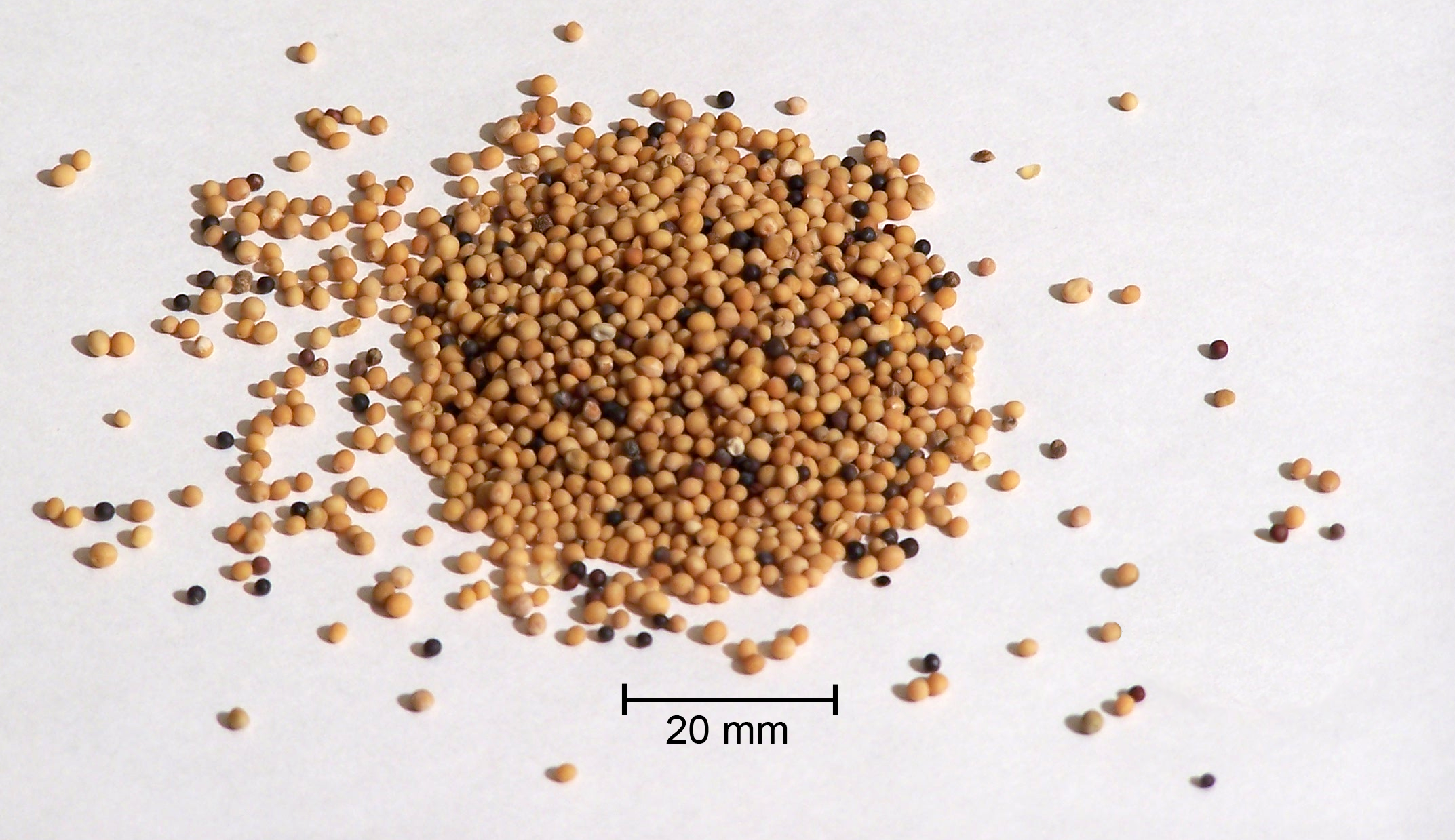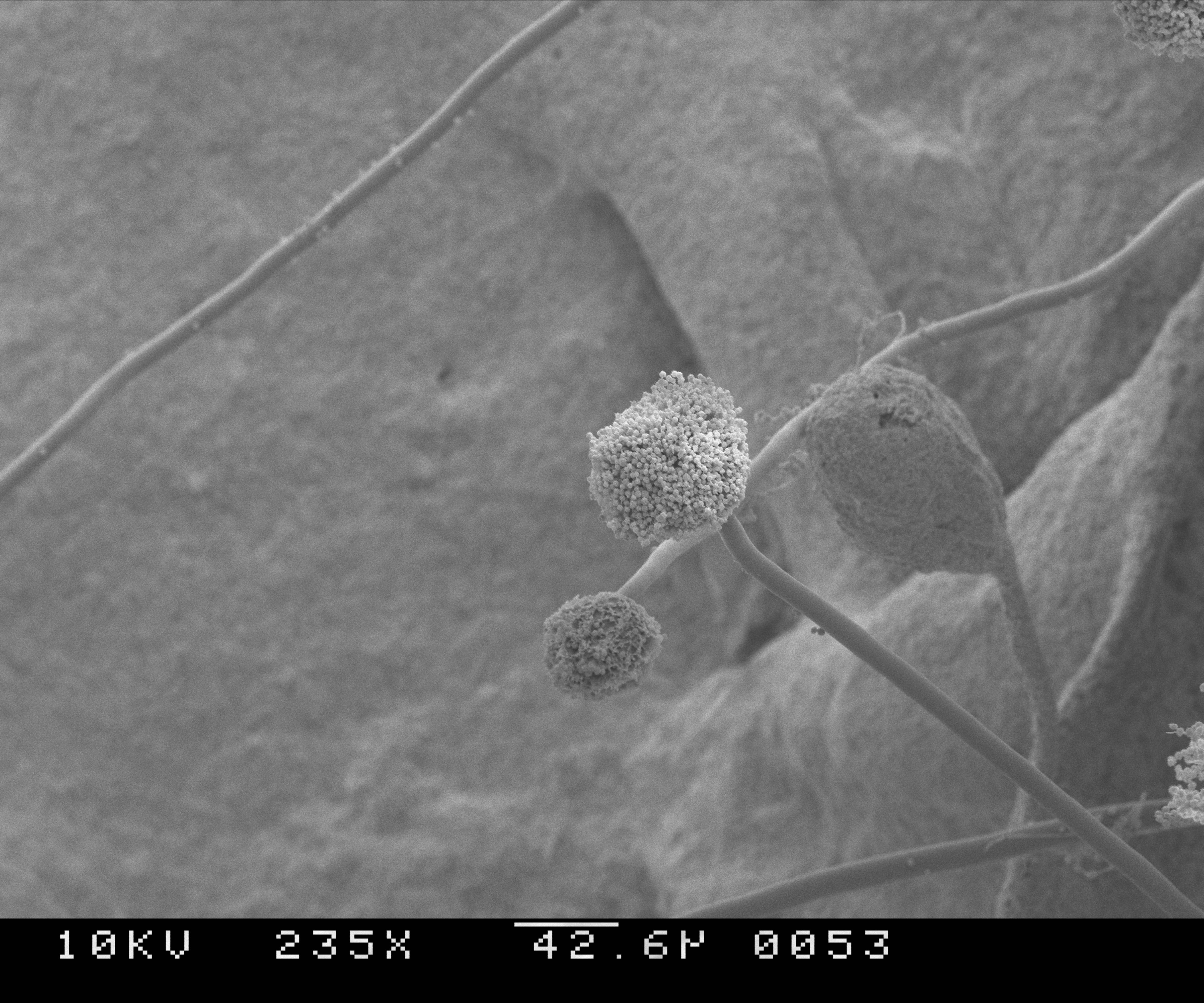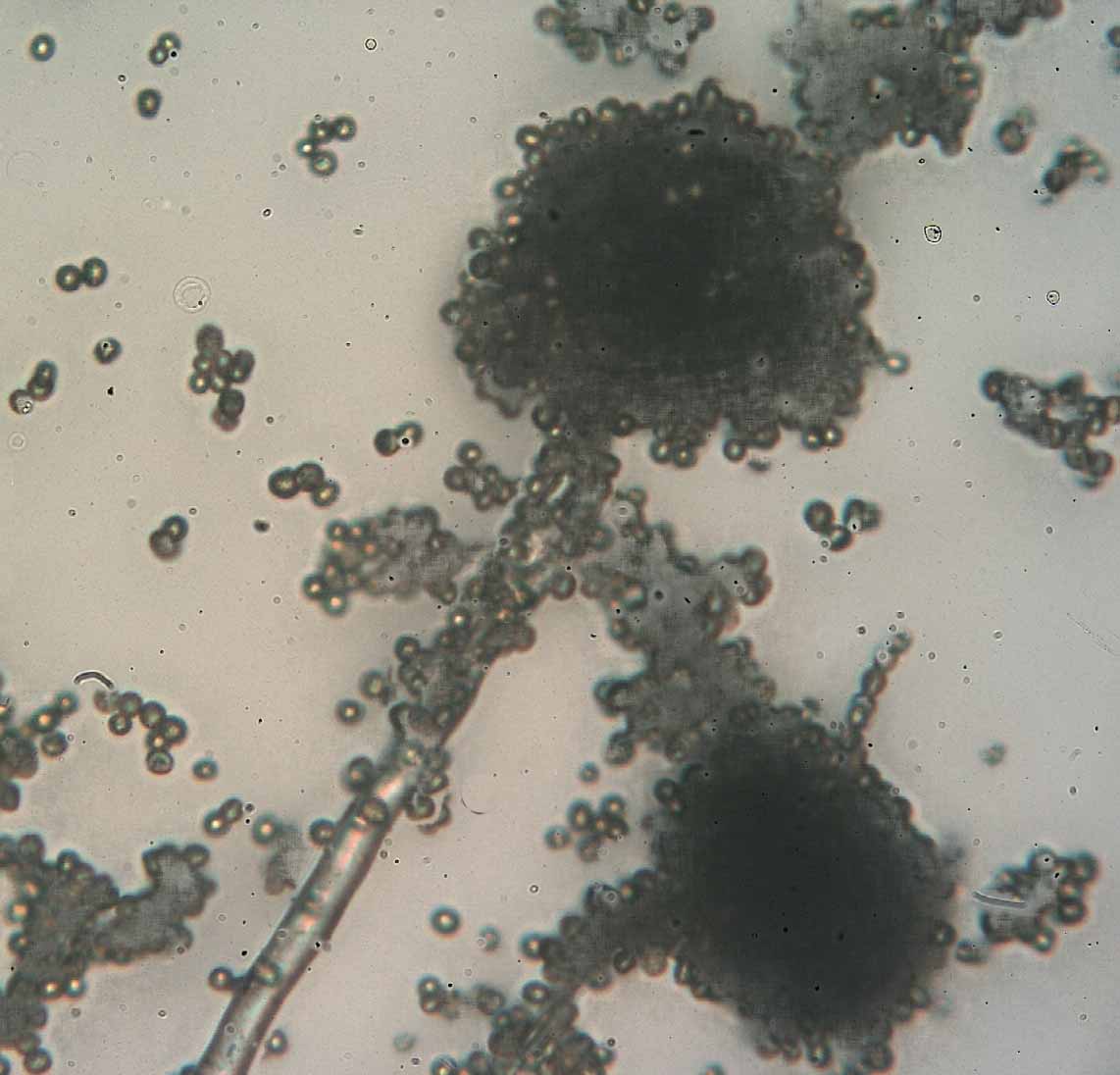|
Mustard Seed
Mustard seeds are the small round seeds of various mustard plants. The seeds are usually about in diameter and may be colored from yellowish white to black. They are an important spice in many regional foods and may come from one of three different plants: black mustard ('' Brassica nigra''), brown mustard ('' B. juncea''), or white mustard ('' Sinapis alba''). Grinding and mixing the seeds with water, vinegar or other liquids creates the yellow condiment known as mustard. Cultivation Mustard seeds generally take eight to ten days to germinate if placed under the proper conditions, which include a cold atmosphere and relatively moist soil. Mature mustard plants grow into shrubs. Yellow mustard has a plant maturity of 85 to 90 days; whereas, brown and oriental mustard have a plant maturity of 90 to 95 days. If the temperature conditions are conducive to growth, a mustard plant will begin to bud five weeks after the seedlings have appeared. The plant will reach full bloo ... [...More Info...] [...Related Items...] OR: [Wikipedia] [Google] [Baidu] |
Mustard
Mustard may refer to: Food and plants * Mustard (condiment), a paste or sauce made from mustard seeds used as a condiment * Mustard plant, one of several plants, having seeds that are used for the condiment ** Mustard seed, small, round seeds of the mustard plant used in cooking * Mustard greens (''Brassica juncea''), edible leaves from a variety of mustard plant * Mustard oil * Mustard family, or Brassicaceae, a family of plants * Mustard tree, or ''Salvadora persica'' * Betel vine, produces the fresh fruit mustard stick * Tomalley, sometimes called the "mustard" of a crab or lobster Science and technology * Mustard (color), a dull/dark shade of yellow, similar to the color of the condiment * BAC Mustard (Multi-Unit Space Transport and Recovery Device), an experimental British spacecraft * Mustard gas or sulfur mustard, a chemical weapon * Nitrogen mustard, chemotherapy agents derived from mustard gas Other uses * Mustard (name), including a list of people with the nam ... [...More Info...] [...Related Items...] OR: [Wikipedia] [Google] [Baidu] |
Aspergillus
'''' () is a genus consisting of several hundred mold species found in various climates worldwide. ''Aspergillus'' was first catalogued in 1729 by the Italian priest and biologist Pier Antonio Micheli. Viewing the fungi under a microscope, Micheli was reminded of the shape of an '' aspergillum'' (holy water sprinkler), from Latin ''spargere'' (to sprinkle), and named the genus accordingly. Aspergillum is an asexual spore-forming structure common to all ''Aspergillus'' species; around one-third of species are also known to have a sexual stage. While some species of ''Aspergillus'' are known to cause fungal infections, others are of commercial importance. Taxonomy Species In March 2010, ''Aspergillus'' covered 837 species of fungi. Notable species placed in Aspergillus include: * '' Aspergillus flavus'' is a notable plant pathogen impacting crop yields and a common cause of aspergillosis. * '' Aspergillus fumigatus'' is the most common cause of aspergillosis in individuals ... [...More Info...] [...Related Items...] OR: [Wikipedia] [Google] [Baidu] |
Soil Amendment
A soil conditioner is a product which is added to soil to improve the soil’s physical qualities, usually its fertility (ability to provide nutrition for plants) and sometimes its mechanics. In general usage, the term "soil conditioner" is often thought of as a subset of the category soil amendments (or soil improvement, soil condition), which more often is understood to include a wide range of fertilizers and non-organic materials. In the context of construction soil conditioning is also called soil stabilization. Soil conditioners can be used to improve poor soils, or to rebuild soils which have been damaged by improper soil management. They can make poor soils more usable, and can be used to maintain soils in peak condition. Composition A wide variety of materials have been described as soil conditioners due to their ability to improve soil quality. Some examples include biochar, bone meal, blood meal, coffee grounds, compost, compost tea, coir, manure, straw, peat, sphagn ... [...More Info...] [...Related Items...] OR: [Wikipedia] [Google] [Baidu] |
Mangoes
A mango is an edible stone fruit produced by the tropical tree ''Mangifera indica''. It originated from the region between northwestern Myanmar, Bangladesh, and northeastern India. ''M. indica'' has been cultivated in South and Southeast Asia since ancient times resulting in two types of modern mango cultivars: the "Indian type" and the "Southeast Asian type". Other species in the genus ''Mangifera'' also produce edible fruits that are also called "mangoes", the majority of which are found in the Malesian ecoregion. Worldwide, there are several hundred cultivars of mango. Depending on the cultivar, mango fruit varies in size, shape, sweetness, skin color, and flesh color, which may be pale yellow, gold, green, or orange. Mango is the national fruit of India, Pakistan and the Philippines, while the mango tree is the national tree of Bangladesh. Etymology The English word ''mango'' (plural ''mangoes'' or ''mangos'') originated in the 16th century from the Portuguese wo ... [...More Info...] [...Related Items...] OR: [Wikipedia] [Google] [Baidu] |
Pickling
Pickling is the process of food preservation, preserving or extending the shelf life of food by either Anaerobic organism, anaerobic fermentation (food), fermentation in brine or immersion in vinegar. The pickling procedure typically affects the food's texture and flavor. The resulting food is called a ''pickle'', or, if named, the name is prefaced with the word "pickled". Foods that are pickled include vegetables, fruits, mushrooms, meats, fish, dairy and eggs. Pickling solutions are typically highly acidic, with a pH of 4.6 or lower, and high in salt, preventing Enzyme, enzymes from working and micro-organisms from multiplying. Pickling can preserve Decomposition, perishable foods for months, or in some cases years. Antimicrobial herbs and spices, such as mustard seed, garlic, cinnamon or cloves, are often added. If the food contains sufficient moisture, a pickling brine may be produced simply by adding dry salt. For example, sauerkraut and Korean kimchi are produced by salti ... [...More Info...] [...Related Items...] OR: [Wikipedia] [Google] [Baidu] |
South Asian Cuisine
South Asian cuisine includes the traditional cuisines from the modern-day South Asian republics of Bangladesh, India, Maldives, Nepal, Pakistan and Sri Lanka, also sometimes including the kingdom of Bhutan and the emirate of Afghanistan. Also sometimes known as Desi cuisine, it has been influenced by and also has influenced other Asian cuisines beyond the Indian subcontinent. Staples and common ingredients Chapati, a type of flat bread, is a common part of meals to be had in many parts of the Indian subcontinent. Other staples from many of the cuisines include rice, roti made from atta flour, and beans. Foods in this area of the world are flavoured with various types of chilli, black pepper, cloves, and other strong herbs and spices along with the flavoured butter ghee. Ginger is an ingredient that can be used in both savory and sweet recipes in cuisines from the subcontinent. Chopped ginger is fried with meat, and pickled ginger is often an accompaniment to boiled rice. Ginge ... [...More Info...] [...Related Items...] OR: [Wikipedia] [Google] [Baidu] |
Mustard Oil
Mustard oil can mean either the pressed oil used for cooking or a pungent essential oil, also known as volatile oil, of the mustard plant. The essential oil results from grinding mustard seed, mixing the grounds with water, and isolating the resulting volatile oil by distillation. It can also be produced by dry distillation of the seed. Pressed mustard oil is used as cooking oil in some cultures; however, sale is restricted in some countries due to high levels of erucic acid. Variations of mustard seeds low in erucic acid have been cultivated at times. History Mustard oil was likely produced in the ancient Jewish town of Huqoq, in modern-day Israel. This is suggested by distinctive agricultural features found there, such as semi-circular wine vats with steep slopes and lower troughs. Scholars believe these structures, dating to Roman Empire, Roman or Byzantine Empire, Byzantine times, were used to crush mustard pods to make oil. Mustard production in Huqoq is also documented in th ... [...More Info...] [...Related Items...] OR: [Wikipedia] [Google] [Baidu] |
South Asia
South Asia is the southern Subregion#Asia, subregion of Asia that is defined in both geographical and Ethnicity, ethnic-Culture, cultural terms. South Asia, with a population of 2.04 billion, contains a quarter (25%) of the world's population. As commonly conceptualised, the modern State (polity), states of South Asia include Bangladesh, Bhutan, India, the Maldives, Nepal, Pakistan, and Sri Lanka, with Afghanistan also often included, which may otherwise be classified as part of Central Asia. South Asia borders East Asia to the northeast, Central Asia to the northwest, West Asia to the west and Southeast Asia to the east. Apart from Southeast Asia, Littoral South Asia, Maritime South Asia is the only subregion of Asia that lies partly within the Southern Hemisphere. The British Indian Ocean Territory and two out of Atolls of Maldives, 26 atolls of the Maldives in South Asia lie entirely within the Southern Hemisphere. Topographically, it is dominated by the Indian subcontinent ... [...More Info...] [...Related Items...] OR: [Wikipedia] [Google] [Baidu] |
Prepared Mustard
Mustard is a condiment made from the seeds of a mustard plant (white/yellow mustard, ''Sinapis alba''; brown mustard, ''Brassica juncea''; or black mustard, ''Brassica nigra''). The whole, ground, cracked, or bruised mustard seeds are mixed with water, vinegar, lemon juice, wine, or other liquids, salt, and often other flavorings and spices, to create a paste or sauce ranging in color from bright yellow to dark brown. The seed itself has a strong, pungent, and somewhat bitter taste. The taste of mustard condiments ranges from sweet to spicy. Mustard is commonly paired with meats, vegetables and cheeses, especially as a condiment for sandwiches, hamburgers, and hot dogs. It is also used as an ingredient in many dressings, glazes, sauces, soups, relishes, and marinades. As a paste or as individual seeds, mustard is used as a condiment in the cuisine of India and Bangladesh, the Mediterranean, northern and southeastern Europe, Asia, the Americas, and Africa, making it one of t ... [...More Info...] [...Related Items...] OR: [Wikipedia] [Google] [Baidu] |
Bangladesh
Bangladesh, officially the People's Republic of Bangladesh, is a country in South Asia. It is the List of countries and dependencies by population, eighth-most populous country in the world and among the List of countries and dependencies by population density, most densely populated with a population of over 171 million within an area of . Bangladesh shares land borders with India to the north, west, and east, and Myanmar to the southeast. It has a coastline along the Bay of Bengal to its south and is separated from Bhutan and Nepal by the Siliguri Corridor, and from China by the List of Indian states, Indian state of Sikkim to its north. Dhaka, the capital and list of cities and towns in Bangladesh, largest city, is the nation's political, financial, and cultural centre. Chittagong is the second-largest city and the busiest port of the country. The territory of modern Bangladesh was a stronghold of many List of Buddhist kingdoms and empires, Buddhist and List of Hindu empir ... [...More Info...] [...Related Items...] OR: [Wikipedia] [Google] [Baidu] |
Rhizopus
''Rhizopus'' is a genus of common saprophytic fungi on plants and specialized parasites on animals. They are found in a wide variety of organic substances, including "mature fruits and vegetables", jellies, syrups, leather, bread, peanuts, and tobacco. They are multicellular. Some ''Rhizopus'' species are opportunistic human pathogens that often cause fatal disease called mucormycosis. This widespread genus includes at least eight species. ''Rhizopus'' species grow as filamentous, branching hyphae that generally lack cross-walls (i.e., they are coenocytic). They reproduce by forming asexual and sexual spores. In asexual reproduction, spores are produced inside a spherical structure, the sporangium. Sporangia are supported by a large apophysate columella atop a long stalk, the sporangiophore. Sporangiophores arise among distinctive, root-like rhizoids. In sexual reproduction, a dark zygospore is produced at the point where two compatible mycelia fuse. Upon germination, a zygosp ... [...More Info...] [...Related Items...] OR: [Wikipedia] [Google] [Baidu] |
Penicillium
''Penicillium'' () is a genus of Ascomycota, ascomycetous fungus, fungi that is part of the mycobiome of many species and is of major importance in the natural environment, in food spoilage, and in food and drug production. Some members of the genus produce penicillin, a molecule that is used as an antibiotic, which kills or stops the growth of certain kinds of bacteria. Other species are used in cheesemaking. According to the ''Dictionary of the Fungi'' (10th edition, 2008), the widespread genus contains over 300 species. Taxonomy The genus was first described in the scientific literature by Johann Heinrich Friedrich Link in his 1809 work ; he wrote, , () where means "having tufts of fine hair". Link included three species—''Penicillium candidum, P. candidum'', ''Penicillium expansum, P. expansum'', and ''Penicillium glaucum, P. glaucum''—all of which produced a brush-like conidiophore (asexual spore-producing structure). The common apple rot fungus ''P.&n ... [...More Info...] [...Related Items...] OR: [Wikipedia] [Google] [Baidu] |







